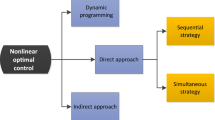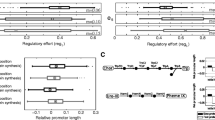Abstract
The regulation of cellular metabolism facilitates robust cellular operation in the face of changing external conditions. The cellular response to this varying environment may include the activation or inactivation of appropriate metabolic pathways. Experimental and numerical observations of sequential timing in pathway activation have been reported in the literature. It has been argued that such patterns can be rationalized by means of an underlying optimal metabolic design. In this paper we pose a dynamic optimization problem that accounts for time-resource minimization in pathway activation under constrained total enzyme abundance. The optimized variables are time-dependent enzyme concentrations that drive the pathway to a steady state characterized by a prescribed metabolic flux. The problem formulation addresses unbranched pathways with irreversible kinetics. Neither specific reaction kinetics nor fixed pathway length are assumed.
In the optimal solution, each enzyme follows a switching profile between zero and maximum concentration, following a temporal sequence that matches the pathway topology. This result provides an analytic justification of the sequential activation previously described in the literature. In contrast with the existent numerical approaches, the activation sequence is proven to be optimal for a generic class of monomolecular kinetics. This class includes, but is not limited to, Mass Action, Michaelis–Menten, Hill, and some Power-law models. This suggests that sequential enzyme expression may be a common feature of metabolic regulation, as it is a robust property of optimal pathway activation.
Article PDF
Similar content being viewed by others
Avoid common mistakes on your manuscript.
References
Alves, R., Savageau, M.A., 2000. Extending the method of mathematically controlled comparison to include numerical comparisons. Bioinformatics 16(9), 786–798.
Banga, J., Balsa-Canto, E., Moles, C., Alonso, A., 2005. Dynamic optimization of bioprocesses: Efficient and robust numerical strategies. J. Biotechnol. 117, 407–419.
Bilu, Y., Shlomi, T., Barkai, N., Ruppin, E., 2006. Conservation of expression and sequence of metabolic genes is reflected by activity across metabolic states. PLoS Comput. Biol. 2(8), 932–938.
Brown, G., 1991. Total cell protein concentration as an evolutionary constraint on the metabolic control distribution in cells. J. Theor. Biol. 153, 195–203.
Campbell, N., 2004. Timing is everything. Nat. Rev. Genet. 5, 405.
Chaves, M., Albert, R., Sontag, E., 2005. Robustness and fragility of Boolean models for genetic regulatory network. J. Theor. Biol. 235, 431–449.
Cornish-Bowden, A., 2004a. Fundamentals of Enzyme Kinetics, 3rd edn. Portland Press.
Cornish-Bowden, A., 2004b. The Pursuit of Perfection: Aspects of Biochemical Evolution. Oxford University Press, USA.
Heinrich, R., Klipp, E., 1996. Control analysis of unbranched enzymatic chains in states of maximal activity. J. Theor. Biol. 182, 242–252.
Heinrich, R., Schuster, S., 1996. The Regulation of Cellular Systems. Chapman & Hall, London.
Heinrich, R., Schuster, S., Holzhütter, H.G., 1991. Mathematical analysis of enzymatic reaction systems using optimization principles. Eur. J. Biochem. 201, 1–21.
Holzhütter, H.-G., 2004. The principle of flux minimization and its application to estimate stationary fluxes in metabolic networks. Eur. J. Biochem. 271, 2905–2922.
Ibarra, R., Edwards, J., Palsson, B., 2002. Escherichia coli K-12 undergoes adaptive evolution to achieve in silico predicted optimal growth. Nature 420, 186–189.
Kalir, S., McClure, J., Pabbaraju, K., Southward, C., Ronen, M., Leibler, S., Surette, M.G., Alon, U., 2001. Ordering genes in a flagella pathway by analysis of expression kinetics from living bacteria. Science 292, 2080–2083.
Klipp, E., Heinrich, R., 1999. Competition for enzymes in metabolic pathways: Implications for optimal distributions of enzyme concentrations and for the distribution of flux control. Biosystems 54, 1–14.
Klipp, E., Heinrich, R., Holzhütter, H.G., 2002. Prediction of temporal gene expression: Metabolic optimization by re-distribution of enzyme activities. Eur. J. Biochem. 269, 5406–5413.
Klipp, E., Herwig, R., Kowald, A., Wierling, C., Lehrach, H., 2005. Systems Biology in Practice: Concepts, Implementation and Application. Wiley-Vch, New York.
Leng, X., Müller, H.-G., 2006. Time ordering of gene coexpression. Biostatistics 7(4), 569–584.
Llorens, M., Nuno, J., Rodriguez, Y., Melendez-Hevia, E., Montero, F., 1999. Generalization of the theory of transition times in metabolic pathways: A geometrical approach. Biophys. J. 77, 22–36.
Mahadevan, R., Edwards, J., Doyle, F., 2002. Dynamic flux balance analysis of diauxic growth in Escherichia coli. Biophys. J. 83, 1331–1340.
Meléndez-Hevia, E., Torres, N., Sicilia, J., 1990. A generalization of metabolic control analysis to conditions of no proportionality between activity and concentrations of enzymes. J. Theor. Biol. 142, 443–451.
Nielsen, J., 2007. Principles of optimal network operation. Mol. Syst. Biol. 3(126), 00–00.
Ou, J., Yamada, T., Nagahis, K., Hirasawa, T., Furusawa, C., Yomo, T., Shimizu, H., 2008. Dynamic change in promoter activation during lysine biosynthesis in Escherichia coli cells. Mol. Biosyst. 4, 128–134.
Oyarzún, D., Ingalls, B., Kalamatianos, D., 2007. Optimal metabolic regulation by time varying enzyme activities: A control theoretic approach. In: Proceedings of Foundations of Systems Biology & Engineering, Stuttgart, Germany
Pontryagin, L.S., Boltyanskii, V., Gamkrelidze, R., Mischenko, F., 1962. The Mathematical Theory of Optimal Processes. New York, Wiley (transl. by K.M. Tririgoff).
Rutquist, P., Edvall, M., (2009) PROPT—Matlab Optimal Control Software, Tomlab Optimization Inc., 260 SE Bishop Blvd Ste E, Pullman, WA 99163, USA, February 2009
Savageau, M.A., 1974. Optimal design of feedback control by inhibition: steady state considerations. J. Mol. Evol. 4, 139–156.
Savageau, M.A., 1975. Optimal design of feedback control by inhibition: Dynamic considerations. J. Mol. Evol. 5(3), 199–222.
Savageau, M.A., 1976. Biochemical Systems Analysis: a Study of Function and Design in Molecular Biology. Addison–Wesley, Reading.
Savageau, M.A., 1985. A theory of alternative designs for biochemical control systems. Biomed. Biochim. Acta 44(6), 875–880.
Schuetz, R., Kuepfer, L., Sauer, U., 2007. Systematic evaluation of objective functions for predicting intracellular fluxes in Escherichia coli. Mol. Syst. Biol. 3, 119.
Schuster, S., Pfeiffer, T., Fell, D., 2008. Is maximization of molar yield in metabolic networks favoured by evolution? J. Theor. Biol. 252(3), 497–504.
Torres, N., 1994. Application of the transition time of metabolic systems as a criterion for optimization of metabolic processes. Biotechnol. Bioeng. 44, 291–296.
Torres, N., Voit, E., 2002. Pathway Analysis and Optimization in Metabolic Engineering. Cambridge University Press, Cambridge.
Uygun, K., Matthew, H., Huang, Y., 2006. DFBA-LQR: An optimal control approach to flux balance analysis. Ind. Eng. Chem. Res. 45, 8554–8564.
van Riel, N., Giuseppin, M., Verrips, C., 2000. Dynamic optimal control of homeostasis: An integrative systems approach for modeling of the central nitrogen metabolism in Saccharomyces cerevisiae. Metab. Eng. 2, 14–33.
Varma, A., Palsson, B., 1994. Metabolic flux balancing—basic concepts, scientific and practical use. Bio-Technology 12(10), 994–998.
Varner, J., Ramkrishna, D., 1999. Metabolic engineering from a cybernetic perspective. 1. Theoretical preliminaries. Biotechnol. Prog. 15, 407–425.
Vera, J., de Atauri, P., Cascante, M., Torres, N., 2003. Multicriteria optimization of biochemical systems by linear programming: Application to production of ethanol by Saccharomyces cerevisiae. Biotechnol. Bioeng. 83, 335–343.
Zaslaver, A., Mayo, A., Rosenberg, R., Bashkin, P., Sberro, H., Tsalyuk, M., Surette, M., Alon, U., 2004. Just-in-time transcription program in metabolic pathways. Nat. Genet. 36(5), 486–491.
Author information
Authors and Affiliations
Corresponding author
Rights and permissions
Open Access This is an open access article distributed under the terms of the Creative Commons Attribution Noncommercial License (https://creativecommons.org/licenses/by-nc/2.0), which permits any noncommercial use, distribution, and reproduction in any medium, provided the original author(s) and source are credited.
About this article
Cite this article
Oyarzún, D.A., Ingalls, B.P., Middleton, R.H. et al. Sequential Activation of Metabolic Pathways: a Dynamic Optimization Approach. Bull. Math. Biol. 71, 1851–1872 (2009). https://doi.org/10.1007/s11538-009-9427-5
Received:
Accepted:
Published:
Issue Date:
DOI: https://doi.org/10.1007/s11538-009-9427-5




